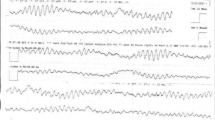Summary
Recent reports have suggested an association between terodiline hydrochloride and cardiac arrhythmias. We report 4 patients presenting over a six month period who developed polymorphic ventricular tachycardia (polymorphic VT) while receiving treatment with this agent. In each case there was prolongation of QT interval on electrocardiogram (ECG). Two patients had hypokalaemia associated with diuretic therapy. In the 3 cases in which follow-up ECG was available, QT interval returned to normal after discontinuation of terodiline.
In order to define the effects of terodiline on corrected QT interval (QTc) and heart rate in the elderly, a prospective study was performed in 8 elderly in-patients treated with terodiline for urinary incontinence. After 7 days treatment with terodiline 12.5 mg twice daily, there was a significant increase in QT by a mean of 29 ms, QTc by 15 ms and a decrease in resting heart rate by a mean of 6.7 beats·min−1.
Terodiline increases QTc and reduces resting heart rate in elderly patients. Both these effects may be associated with polymorphic VT, a potentially life threatening arrhythmia. This drug should be avoided in patients with other known risk factors for polymorphic VT, particularly hypokalaemia and cardiac disease.
Similar content being viewed by others
References
Tapp A, Fall M, Norgaard J, Massey A, Choa R, Carr T, Korhonen M, Abrams P (1989) Terodiline: a dose titrated, multicenter study of the treatment of idiopathic detrusor instability in women. J Urol 142: 1027–1031
Andersen JR, Lose G, Norgaard M, Stimpel H, Andersen JT (1988) Terodiline, emepronium bromide or placebo for treatment of female detrusor overactivity? A randomised double-blind cross-over study. Br J Urol 61: 310–313
Lukkarinen O, Grohn P, Wilen Rosenqvist G, Juusela H, Sotarauta M, Lehtonen T (1987) A controlled double-blind cross-over study of terodiline in motor urge incontinence. Ann Chir Gynaecol 76: 128–132
Gerstenberg TC, Klarskov P, Ramirez D, Hald T (1986) Terodiline in the treatment of women with urgency and motor urge incontinence. A clinical and urodynamic double-blind cross-over study. Br J Urol 58: 129–133
Davies SW, Brecker SJ, Stevenson RN (1991) Terodiline for treating detrusor instability in elderly people. Br Med J 302: 1276
McLeod AA, Thorogood S, Barnett S (1991) Torsades de pointes complicating treatment with terodiline. Br Med J 302: 1469
Connolly MJ, Astridge PS, White EG, Morley CA, Campbell Cowan J (1991) Torsades de pointes ventricular tachycardia and terodiline. Lancet 338: 344–345
Surawicz B, Knoebel SB (1984) Long QT: good, bad or indifferent. J Am Coll Cardiol 4: 398–413
Bazett HC (1920) An analysis of the time relations of electrocardiograms. Heart 7: 353–370
Castellanos A, Myerburg RJ (1986) The resting electrocardiogram. In: Hurst JW (Ed), The Heart. 6th edition. McGraw-Hill New York, pp 206–229
Hallen B, Bogentoft S, Sandquist S, Stromberg S, Setterberg G, Ryd Kjellen E (1989) Tolerability and steady-state pharmacokinetics of terodiline and its main metabolites in elderly patients with urinary incontinence. Eur J Clin Pharmacol 36: 487–493
Noren B, Stromberg S, Ericsson O, Lindeke B (1989) Biotransformation of terodiline. V Stereoselectivity in hydroxylation by human liver microsomes. Chem Biol Interact 71: 325–337
Andersson KE (1984) Clinical Pharmacology of terodiline. Scand J Urol Nephrol [Suppl] 87: 13–20
McLachlan MSF (1978) The ageing kidney. Lancet I: 143–146
Woodhouse KW, James OFW (1990) Hepatic drug metabolism and ageing. British Medical Bulletin 46: 22–35
McKibben JK, Pocock WA, Barlow JB, Scott Millar RN, Obel IW (1984) Sotalol, hypokalaemia, syncope, and torsades de pointes. Br Heart J 51: 157–162
Prevention of atherosclerotic complications: controlled trial of ketanserin (1989) Prevention of atheorsclerotic complications with Ketanserin Trial Group. 298: 424–430
Bigger JT, Hoffman BF (1985) Antiarrhythmic drugs. In: Gilman AG, Goodman LS, Rall TW, Murad F (Eds), Goodman and Gilman's the pharmacological basis of therapeutics. 7th edition. MacMillan, New York, pp 748–783
Petersen T, Jakobsen J (1987) A calcium blocking and anticholinergic agent (terodiline) in the treatment of detrusor hyperre-flexia: a placebo-controlled, cross-over trial. J Neurol Neurosurg Psychiatry 50: 1331–1336
Sorkin EM, Clissold SP (1987) Focus on nicardipine. Drugs 33: 296–345
Funck Brentano C, Coudray P, Planellas J, Motte G, Jaillon P (1990) Effects of bepridil and diltiazem on ventricular repolarization in angina pectoris. Am J Cardiol 66: 812–817
Kerr GD, Ingham G (1990) Torsade de pointes associated with perhexiline maleate therapy. Aust N Z J Med 20: 818–820
Van Wijk LM, van Gelder I, Crijns HJ, van den Toren EW, Lie KI, Ruegg PC (1989) Cardiac electrophysiologic properties of intravenous isradipine in patients with sick sinus syndrome. Am J Med 86: 88–90
Schechter E, Freeman CC, Lazzara R (1984) After depolarisations as a mechanism for the long QT syndrome: electrophysiological studies of a case. J Am Coll Cardiol 3: 1556–1561
Baroy JH, Ungerleider RM, Smith WM, Ideker RE (1983) A mechanism of torsades de pointes in a canine model. Circulation 67: 52–59
Lavoie FW, Gansert GG, Weiss RE (1990) Value of initial ECG findings and plasma drug levels in cyclic antidepressant overdose. Ann Emerg Med 19: 696–700
Kriwisky M, Perry GY, Tarchitsky D, Gutman Y, Kishon Y (1990) Haloperidol-induced torsades de pointes. Chest 98: 482–484
Author information
Authors and Affiliations
Rights and permissions
About this article
Cite this article
Stewart, D.A., Taylor, J., Ghosh, S. et al. Terodiline causes polymorphic ventricular tachycardia due to reduced heart rate and prolongation of QT interval. Eur J Clin Pharmacol 42, 577–580 (1992). https://doi.org/10.1007/BF00265918
Accepted:
Issue Date:
DOI: https://doi.org/10.1007/BF00265918




